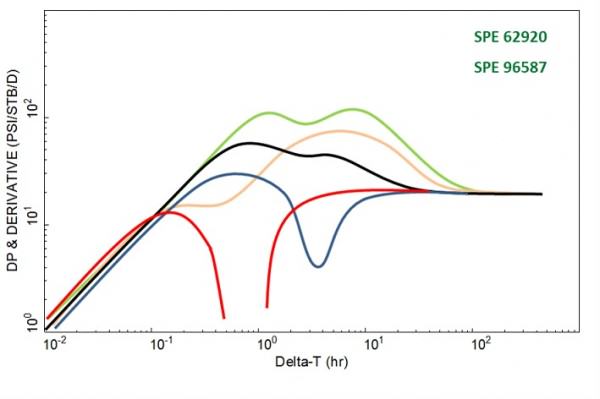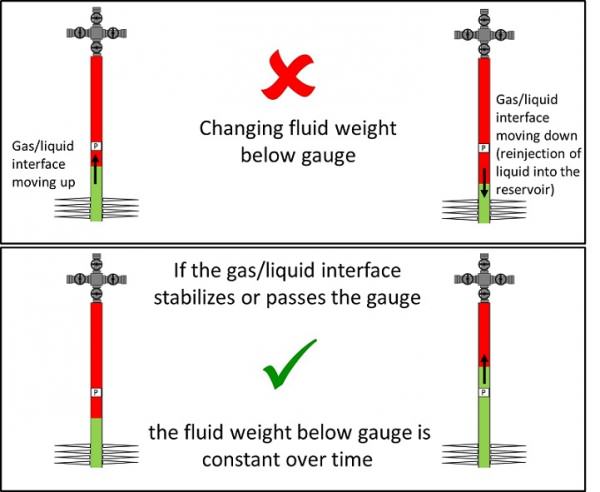If the fluid density between the gauge and the perforations changes over time, the pressure gauge will not give a direct measurement of the pressure at the perforations. The pressure data will be affected by some wellbore dynamic effects and will not be suitable for well test analysis. The data will not be representative of the well and reservoir.
Minimize Wellbore Phase Redistribution
A pressure gauge near the perforations will help to minimize wellbore phase redistribution. For example, during a shut-in with a gas condensate well, liquid droplets will fall down the well and the different phases will get redistributed in the tubing. If a pressure gauge is located at some large distances from the perforations, it is more than likely to have a changing fluid weight and a changing compressibility below the gauge. This results in a changing wellbore storage, unreliable pressure data and some erroneous PBU derivative shapes.
Wellbore phase redistribution could affect any well, even a dry gas producer due to condensed water or a new water injector in an oil field.
The plot below shows the potential impact of wellbore phase redistribution on derivative.
These artificial derivative shapes could be mistakenly taken as genuine flow regimes. For example, the derivative in black could mislead the reservoir engineer into thinking the well has some limited perforations or a composite behaviour created by a gas breakout (oil well) or liquid dropout (gas condensate well). This could result in a wrong well management or wellwork campaign.
On our gas condensate well example, a gas/liquid interface could get formed and move up slowly in the tubing. If the interface stabilizes or passes the gauge, then the fluid weight below the gauge will be constant over time and the pressure at the gauge a direct measurement of the pressure at the perforations. Then the gauge pressure data will be representative of the well and reservoir.
However, liquid could be re-injected back into the reservoir due to natural gravity or gas expansion in the tubing. In this case, the fluid below the gauge could become lighter and lighter. As the fluid weight below the gauge changes over time, the pressure at the gauge is not representative of the pressure at the perforations. Data will be influenced by the lighter density and pressure will build up. So, not only this is difficult to spot, but this effect could also take up to few days and dominate the entire PBU behaviour, rendering the shut-in period useless.
To minimize this effect, the pressure gauge should be placed as close as possible to the perforations.
Improve understanding of well and reservoir performance thanks to high quality pressure data
A downhole gauge as close as possible to the perforations will help to improve the understanding of the well and reservoir performance thanks to high quality data. From the complexity of well test analysis, we may already have some challenges to distinguish between reservoir effects and fluid behaviour during a normal test duration. It is critical to obtain high quality downhole gauge data close to the perforations to help the reservoir engineer to identify any future well performance deviation from these wellbore dynamic effects.
In addition, it will reduce uncertainty on parameters such as skin and reservoir pressure.
There is no practical and correct alternative to estimate downhole shut-in pressure data
There is no practical and correct alternatives to estimate downhole pressure data suitable for pressure transient analysis, especially with multiphase flow in the well. If you happen to find a correlation between wellhead pressure WHP and bottom-hole pressure BHP that perfectly works, there is no guarantee that it is going to work in the future as fluid composition changes, rate changes with flow regimes, etc… This might not be an issue if you are only interested in average reservoir pressure but it will certainly be one for pressure transient analysis.
There are some methods to estimate bottom-hole pressure BHP data. These alternatives should be contemplated as a last resort when a downhole gauge cannot be installed due to temperature and pressure constraints, or in case of downhole gauge failure during the production life.
For example with a gas condensate wells, we have:
a) The modified Cullender&Smith correlation, with some PVT adjustments to account for any condensate. This relies on a PVT sample being representative of the wellbore fluid and on metering accuracy. It could temporarily work for dry gas wells.
b) Some empirical correlations to mimic results from the first method a). This could work for a while until flow conditions change.
c) Well performance method, but this will over-estimate the fluid density during shut-in period since it does not account for phase redistribution and changing liquid level.
Any alternative could be experimented by comparing the calculated with the measured PBU data. Even if the downhole pressure data can be matched (with some high precision to have a correct derivative), unfortunately this does not guarantee any future use.




Dear TestWells Team,
if the fluid level “above” the gauge is moving up why it will not affect the test quality and considered only the PBU data is corrupted in case the fluid level “blow” the gauge is not stable.
Best Regards
Mazin
Hi Mazooni80,
Thanks for your comment.
Let’s assume the gas/condensate interface is deeper than the gauge and hasn’t stabilized. The fluid density below the gauge will change over time, so the fluid weight below will keep changing over time. The pressure at the gauge will be affected by this dynamic change.
We need a constant fluid density below the gauge (either as the interface stabilizes or passes the gauge). The pressure at the gauge will then be the pressure at the perforations minus a constant hydrostatic term between the gauge and the perforations. The pressure at the gauge will then be a direct measurement of the pressure at the perforations.
We hope this helps!
Best Regards,
The TestWells team